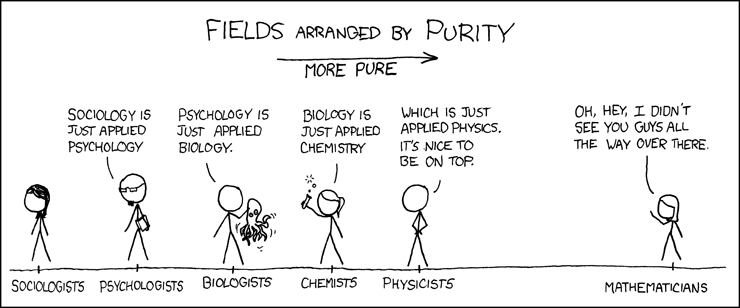Physicists at the Gate: Collaboration and Tribalism in Science
Did you know that most animal species have roughly the same number of heartbeats over the course of their lives? Short-lived creatures’ hearts beat faster, using up their allotment more quickly — mice before humans, humans before elephants — and this universal quality may be the result of the fact that all of our bodies depend on networks of vessels with similar physics. Did you know that as cities grow, the rate of business transactions grows faster than their population, while the number of miles of roads grows slower? Or that building a network of mysterious genes could help reveal the history of malaria?
All of these findings and more have been made in recent years by researchers reaching across the boundaries of their scientific fields. They are the focus of physicists collaborating with biologists, archaeologists, sociologists, and others, forming teams to look for questions to answer and new ways to describe the world. “Physics is not conceptually super-interesting anymore, not as interesting as biology and evolution and all things social — at least for me,” says Luis Bettencourt, a physicist at the Santa Fe Institute who once studied the origins of the universe and now studies the growth of cities.
In many cases, these new collaborations have been fueled by an explosion of data pouring in from DNA sequencing, cellphone records and other sources, filled with latent patterns that could reveal more about the systems that created them. “It’s an opportunity for people that are fluent with dealing with data, and modeling data” — in other words, certain kinds of physicists — “to come in and say something,” Bettencourt says.
But as physicists sink their teeth into the data, many are finding that entering another field is not simple. As Bettencourt puts it: “Physicists come at it and say, ‘What’s wrong with these people, biologists and social scientists? There’s all this data … Why don’t you just look at the data and see what it tells you about these systems?’
“People who are in these disciplines and have been educated in them, and have worked in them for a long time, feel like the barbarians are at the gate,” Bettencourt says. “Here come the physicists who don’t understand the concepts that people have been dealing with — and start saying things nobody asked for.”
Tempers can run high. Researcher Tanmoy Bhattacharya, also of the Santa Fe Institute, remembers a meeting between physicists, biologists and linguists. “It was a surprise that it didn’t come to fisticuffs,” he says. “People were actually running around the room.” Fortunately the two groups were separated by a row of tables, “and nobody decided to jump over it.”
That sort of breakdown in diplomatic relations isn’t happening every day. But if the non-physicists are testy about these collaborations, they have their reasons. The patterns that a newcomer uncovers may be ones that people in the field have known about for ages. Lynette Shaw, a sociologist who also trained in physics, notes that without learning about the journey of thought and argument that a field has been through, it’s all too easy for physicists to reinvent the wheel.
That’s something Ralph Kenna and Pádraig Mac Carron, physicists who’ve been studying the characters in the Icelandic Sagas, discovered early on. They noticed that one saga had more interactions between women than others. It turned out to be one that some scholars speculate may in fact have been written by a woman — somewhat unusually, it involves a female main character. They also noticed that the sagas’ social networks resembled real ones. That was interesting, but not all that surprising to humanities scholars who believe the sagas were probably written using real genealogies.
But the physicists were able to provide some unexpected insights, Kenna says, noting that they found the structures of the sagas’ social networks were not as similar as one humanities scholar they talked to had anticipated. Mac Carron says they are simply able to provide “a more quantitative way, rather than a qualitative way” for other researchers to support their views.
On a larger scale, physicists and their potential collaborators may find that their cultures are simply out of sync. Physicists often throw away a lot of information in the process of extracting large patterns from the systems they study. The idea is that if all those details matter, one will circle around and try to deal with them later. But in biology, archaeology, and sociology, information is not so readily disposable — or at least it’s harder to know what to discard. Should you get rid of information about the birthrates of rabbits or the dynamics of a cell’s membrane? How can you tell whether or not they are important to your question?
“In a sense, physics is the easy science,” says archaeologist Tim Kohler, who is currently working on a border-crossing collaboration. Or as computer scientist and engineer Danny Hillis wrote years ago, “Physicists have learned the lesson that a very simple theory of what is going on is often correct. Biologists have learned the opposite lesson: Simple mathematical theories of biology are usually wrong.”
In fairness, that may be because they have different understandings of what “wrong” means. Theoretical ecologists, for instance, try to create mathematical models of ecosystems from the barest of starting materials. They have often been trained as physicists, and they want to capture certain patterns that appear weirdly universal, like the fact that most rainforest species are rare. It turns out that the differences between species — from the mating dances of manakin birds to the predators of a rainforest tree — are not really necessary for that goal, at least not all the time.
Realistic pictures can be generated using nothing beyond the processes of birth, death, and organisms spreading across the landscape. For many ecologists of a more traditional bent — the kind of people who actually discover new species — these models are not particularly satisfying. They can never really explain, wrote Duke University ecologist James S. Clark in a 2012 essay, how species coexist with each other, an idea of primal importance to many researchers. Until someone explains how the world of individual species fades into the abstract world of ecosystem modeling, the theoretical and traditional ecologists may have to agree to disagree about what’s important.
There’s another thing that makes boundary-crossing collaborations difficult, and there’s no getting around it: Many non-physicists just aren’t comfortable with the language of mathematics, and it’s difficult for them to assess what these newcomers are even saying. “There is a general mistrust of outsiders to the field, especially when the outsiders make elementary or rookie mistakes,” says Bhattacharya. “Most people do not know how to deal with an obviously sophisticated technique that they half-understand, which seems to have an obvious mistake. Is the mistake a fatal flaw, or completely incidental? Most people don’t try to figure this out and choose to dismiss the whole thing instead.”
Or they may be nagged by the feeling that they’ve got to bow down to the math. The idea that there is a hierarchy of scientific fields, with physics and math “purer” that others — as captured by the XKCD cartoon below — sometimes makes itself felt acutely.
Non-physicists can be “really intimidated by the math that’s shown up,” says Shaw, the sociologist, adding that “when you’re working with an audience where everyone’s been trained to be beholden to it, you need the background to realize that just because there’s math doesn’t mean it’s good.”
That can lead to sticky social situations. In nearly two years of talking to researchers about their experiences, I have heard a cacophony of views, and while direct confrontations seem rare, people are quick to generalize. The story that comes up again and again is that physicists are the sort to say things like “Let me solve your little problems with math,” while defensive researchers in other fields may snap peevishly, “You don’t understand reality.” It sometimes feels like beneath the outwardly smooth surface of science there’s a great deal of shouting going on.
It can feel, says Shaw, like a high school lunchroom.
So why collaborate at all? It may be a sexy idea, but crossing boundaries isn’t always particularly good for scientists’ job security. Interdisciplinary work often doesn’t fit cleanly into most departments, and it may not look attractive to the committees that decide whether researchers get tenure. And while mathematical models are increasingly welcome in some other fields, their long-term usefulness — which ones actually work and answer important questions — remains to be seen.
Still, the desire to work on something truly new and different is real. And some questions clearly do benefit from the collision of views. Discoveries at the intersection of fields have altered the study of human memory, for instance — physicist John Hopfield helped biologists recognize that brains could work like networks of nodes. The rise of computer modeling in molecular and cell biology has allowed the field to say clearer, more precise things about how complicated systems work. As the joke goes, the psychologist asks the brother of the man who thinks he’s a chicken “Why do you keep him around?” The brother replies, “Well … I need the eggs.”
People who have successfully untangled the lunchroom dynamic, and turned it into more of a conference-room dynamic, have ideas about how to make things better. Many of them come down to unpacking this issue of hierarchy. The idea that some sciences are hard or soft, pure or less pure, is tangled up in more than a century of scientific culture. But probably the most important — and difficult to grapple with — part of it is a reverence for elegance.
In physics and other fields where modeling and prediction are the most important goals, elegant solutions are often highly prized. It’s one reason these fields have captured the public imagination. We all love the idea that the world is essentially simple, and we revel in each announcement that we are part of a mysterious but beautifully ordered system. But if there are elegant solutions to problems like how nation-states arise, how human intelligence works, how the cell evolved, they are at a much higher level than where our knowledge currently stands. “Biological and social sciences ask questions that are way beyond anything we have physical theories for,” says Bettencourt. “They’re new problems.”
An insistence on elegance and a higher social status may go together, but they are unwieldy baggage in a collaboration. Recognizing the inherent messiness of fields like animal behavior and anthropology is a better foundation for reaching an understanding, and maybe even making progress together. Many scientists say it takes about a year of sincere, humble talks between collaborators — often over beers — to get to the point where work can actually begin. “I think humility will get us further,” Shaw says. “You have to abandon a superficial adherence of forms to get to the heart of what science is.” That goes both ways: Speaking up to say that you don’t understand, and you want an explanation, is something Shaw teaches to sociology students learning rigorous statistics for the first time.
Nor should physicists feel they must completely inhabit an unfamiliar field and unquestioningly accept all its rules. Martine Zilversmit, an evolutionary biologist who studies malaria, found her physicist collaborator’s outside point of view invaluable. “He was unencumbered by the assumptions of a biologist,” Zilversmit said. “He didn’t know about any of these old tools, and so he didn’t use them. It was ‘Give me the parameters, and I’ll get you a model and my computer simulation will draw you a picture of what you’re describing to me.’ I found it not just refreshing but really helpful. It saved me a lot of time I had been wasting.”
To work on hard problems, to seek other ways of looking at things — in the end, for people who strive to make these collaborations work, there’s nothing better. “I think that that is the joy of being a scientist: That first and foremost we learn,” Bettencourt says. “And then we may, if we’re lucky and have discovered enough, come up with something new that no one’s quite figured out yet.”
Veronique Greenwood is a science journalist whose work has been published in The New York Times Magazine, Discover Magazine, and Scientific American, among others.











